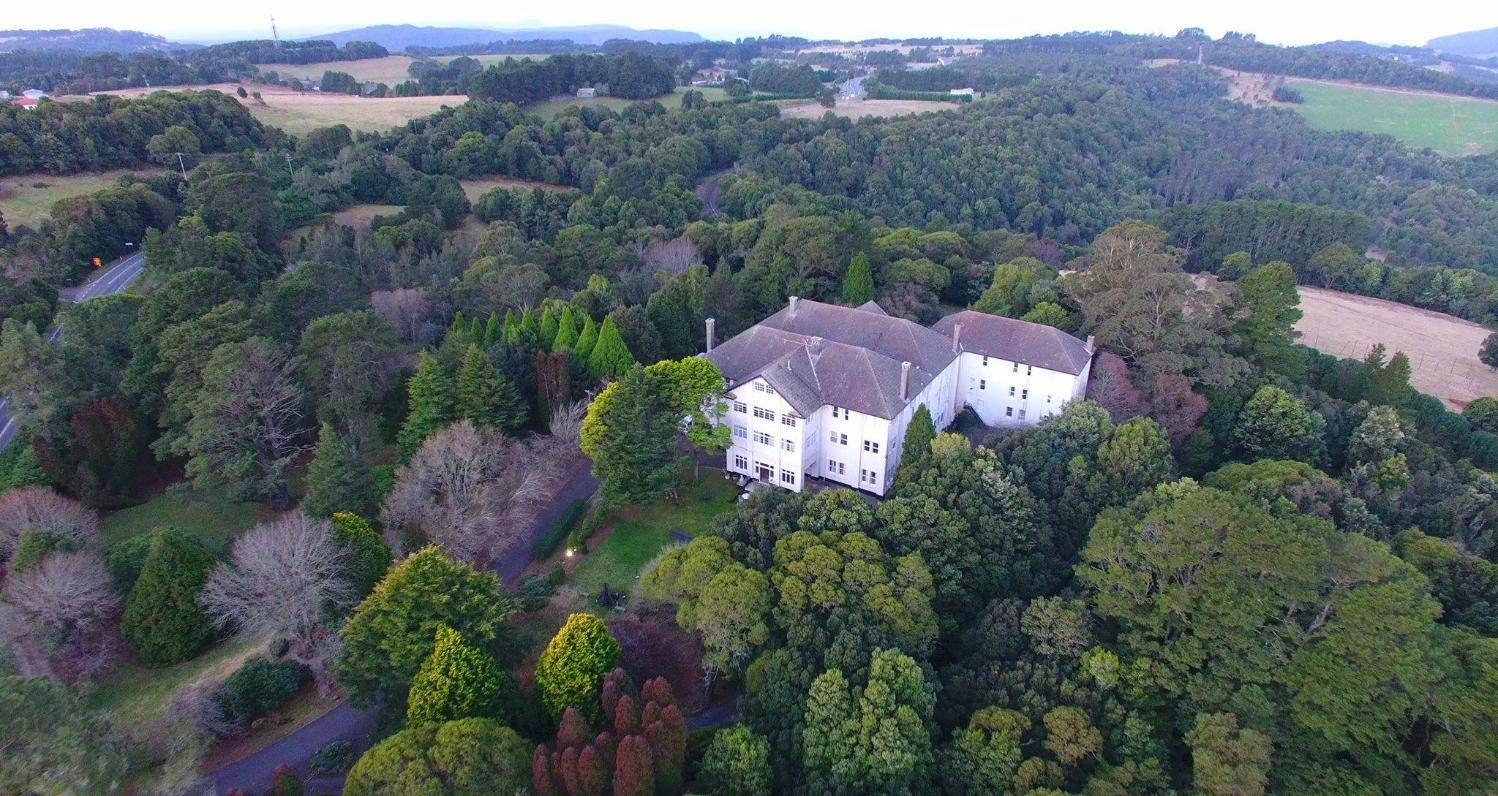March 15 - 21, 2020: Issue 442
Ranelagh Hotel 'Mist' Scent Bottle (Robertson Hotel): Collecting Vintage And Antique Perfume Decanters
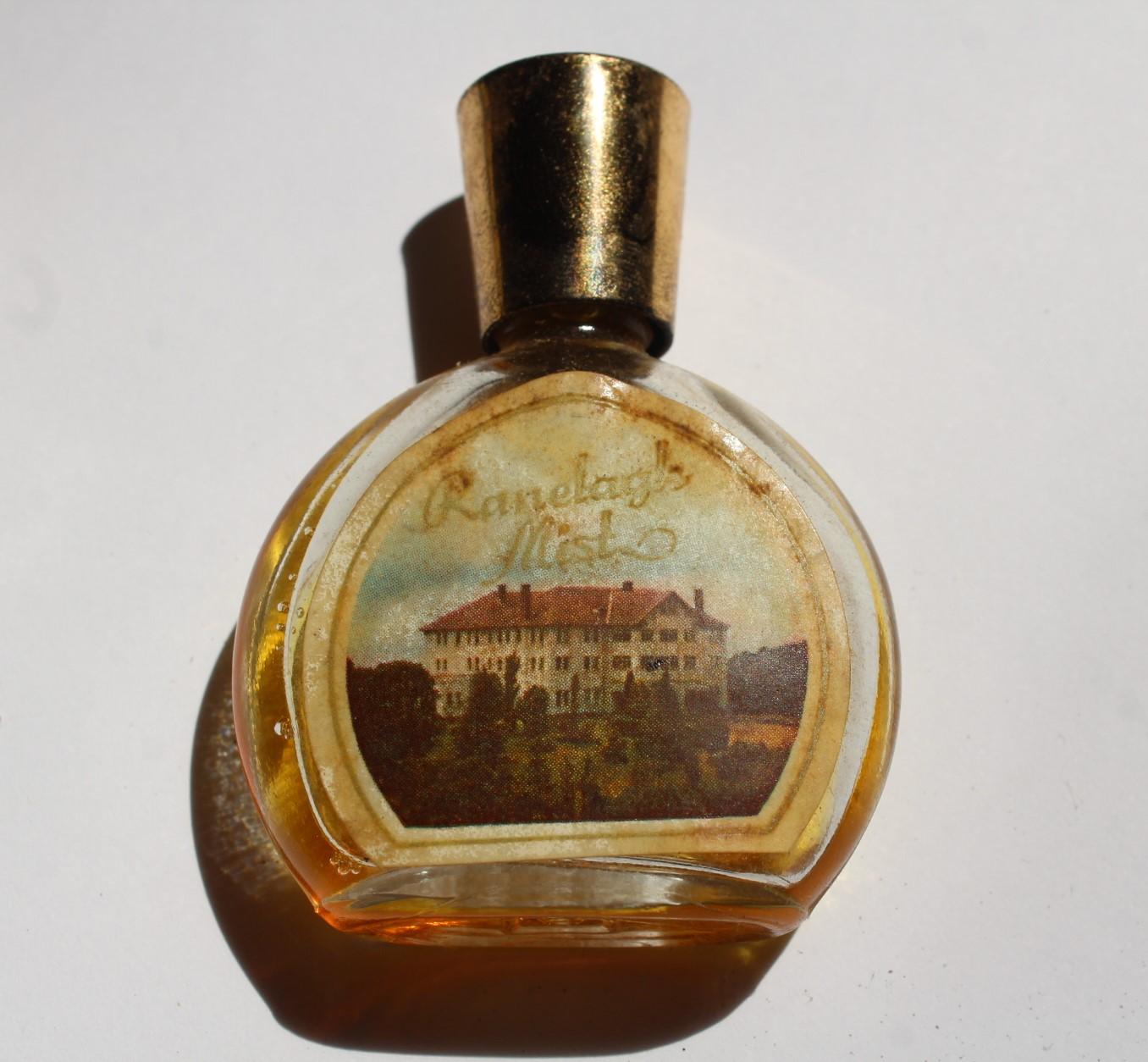
Considering how beautiful and ornate some of these small bottles can be, Vintage and Antique perfume bottles can fetch a good price for those keen on collecting them. As with collecting all things, doing your history research is paramount and knowing what kinds of glass, shapes, eras, series and even brands of perfume are involved will ensure you acquire a genuine article. Those that have been well looked after and in great condition will, likewise, fetch better prices - as will the rare item.
A world record price for a René Lalique Perfume Bottle was reached in 2012 when it fetched $370,000. Frances' René Lalique was a giant when it came to small perfume bottles, which he produced in a series of ever-larger factories outside of Paris for François Coty and other perfume makers. Lalique brought his jeweller's eye to perfume bottles—he even used a jewellery-casting process called cire perdue, also known as lost wax.
Unlike a lot of his contemporaries, Lalique did not add lead to his crystal. Instead, he preferred a demi-crystal because it was inexpensive, easy to work with, and imbued his perfume bottles with what became his trademark milky opalescence. During Lalique’s collaboration with Coty, which lasted through the 1930s, he also made perfume bottles for d’Orsay and Roger et Gallet. One such bottle for Roger et Gallet was crowned by an elaborate tiara stopper, one of Lalique’s most copied designs. Another was an opaque green circular bottle with a bird on one side and the words "LE JADE" at the bottom. Later, as Lalique’s name became as synonymous with perfume bottles as Coty’s, he would make empty vessels so that customers could transfer their perfumes into Lalique’s more elegant containers. Tantot and Amphitrite are just two examples of unfilled Lalique perfume bottles.
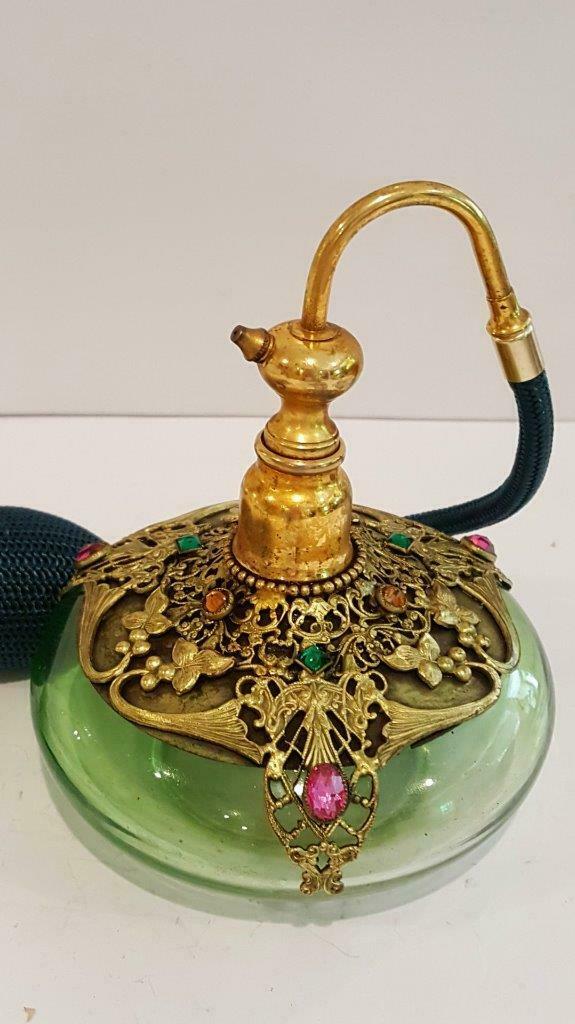
Rare Antique Jewelled Green Glass E & J B Empire (1920's) Art Gold Perfume Atomiser bottle: currently for sale at US$680.00
In Victorian days scent bottles were often made of pressed glass, with silver or silver-plate rims and cut glass or imitation cut glass stoppers. Customers purchased the bottle empty and had it filled by a chemist or perfumier, as ready filled bottles of perfume were not yet on the market. The variety of shapes was enormous. The larger scent bottles were made in the shape of flagons or decanters.
In the 1870s a new design appeared, the double ended bottle. This was a slim cylindrical bottle with a round or polygonal surface. Some were produced in clear glass, some coloured dark blue, red, green, or yellow, and some were decorated in the Nailsea style. At each end were silver or plated caps, which were heavily chased or moulded. One half of the bottle was for scent and usually had a screw cap, while the other end was hinged, often spring loaded for fast access, and was for smelling salts. Some bottles hinged in the middle, and when you opened them there was the grating of a vinaigrette on one side and on the other a recess with a glass-covered photograph. The outer ends had normal hinge- or screw-caps so that either part of the bottle could be filled with scent.
For collectors, a sweet spot for antique perfume bottles is Art Nouveau. Beginning around 1890, artisans and glass factories alike produced elaborate cut or blown glass perfume bottles with ornate caps, some of which had hinged silver stoppers and collars. Purse-sized conical bottles with very short necks and round stoppers were often decorated with gilt flower-and-leaf patterns; manufacturers included Thomas Webb & Sons and Stevens & Williams Glass Company, both from Staffordshire, England.
The same companies also produced perfume bottles in cameo glass. Again, leaves and flowers were popular motifs, in colours that ranged from pink to purple to green, all of which were encased in white. In the United States, Steuben manufactured bulb-shaped perfume bottles using the company’s Verre de Soie technique, with glass threads wrapping the piece and matching the colour of its iridescent base. Tiffany’s bottles included short, stumpy crystal cylinders with hob-nail bottoms and ornately engraved silver caps that covered the bottle’s crystal stopper.
During the 1920s and ’30s, glass perfume bottles inspired by the Art Deco movement were all the rage. Natural forms and motifs gave way to geometric shapes and bold, streamlined designs. In Czechoslovakia, perfume bottles from this era are routinely made of blown and meticulously cut crystal. For some of these bottles, the diameters of the stoppers were a great as those of the bottles beneath them, giving these otherwise simple containers the look of a Vegas showgirl wearing an impossibly top-heavy headdress.
But between the wars, Paris was the place for perfume and perfume bottles. Signature shapes for Chanel No. 5 and Shalimar by Guerlain were codified, and beautiful collaborations took place between Baccarat, the legendary maker of fine crystal, and everyone from Guerlain to fashion designer Elsa Schiaparelli. For Guerlain, Baccarat created the Japanese-influenced Liu bottle, with its square-sided black body adorned gold labels. For Schiaparelli, Baccarat produced a bottle in the shape of a candle in a candlestick, with a gilt-metal flame for a stopper. [1.]
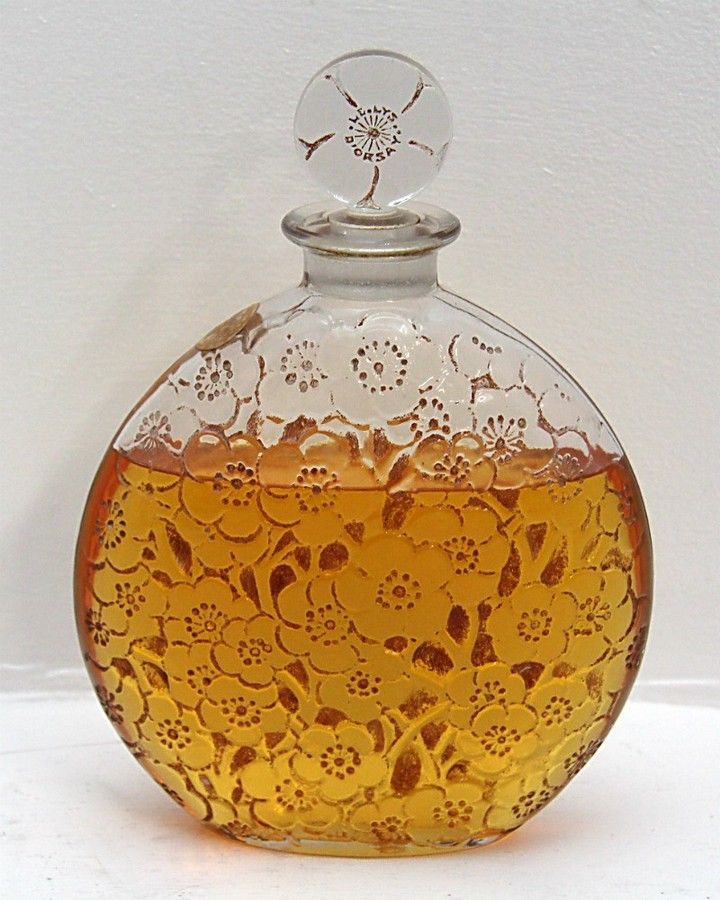
A Rene Lalique perfume flagon and stopper, presently with original perfume contained within, moulded with raised and chased flower head decoration, modelled for D'Orsay, Le Lys perfume, modelled in 1922. 25.5 cm high.
Of course, you don't need to spend hundreds of thousands of dollars - Vintage and Antique perfume bottles can be collected starting from just a few dollars each or just watch out for someone emptying one and preparing to recycle it - and then .... grab that glass!
And how does the residue 'Ranelagh Mist' perfume smell? Like perfume, very strong, perhaps due to its age - and not like what a mist at Robertson would smell like at all!
This bottle has been kept as a memento though, possibly a lovely walk through Robertson mist around this grand old place itself.
References
1. Collectors Weekly - https://www.collectorsweekly.com/
2. TROVE - National Library of Australia
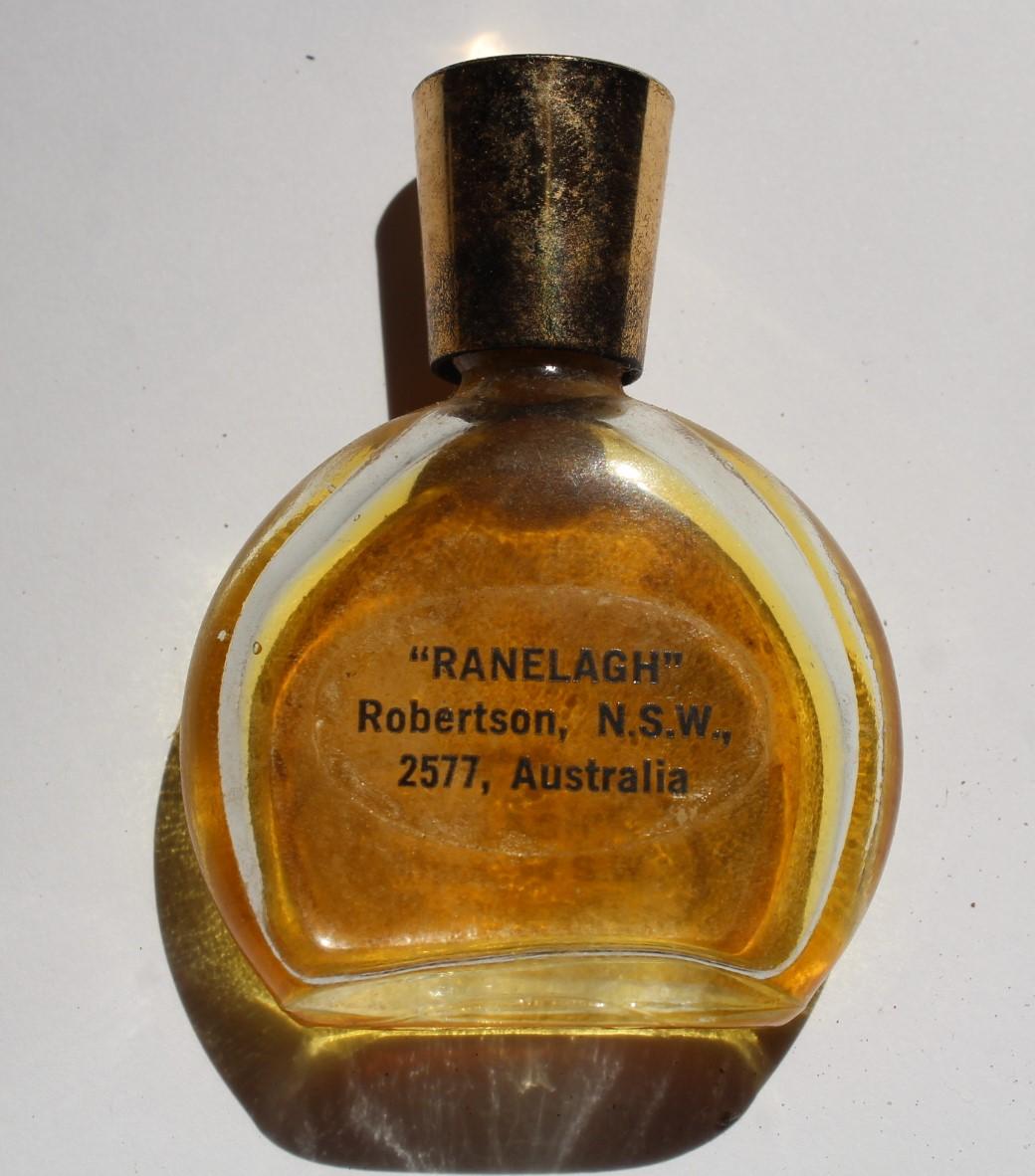
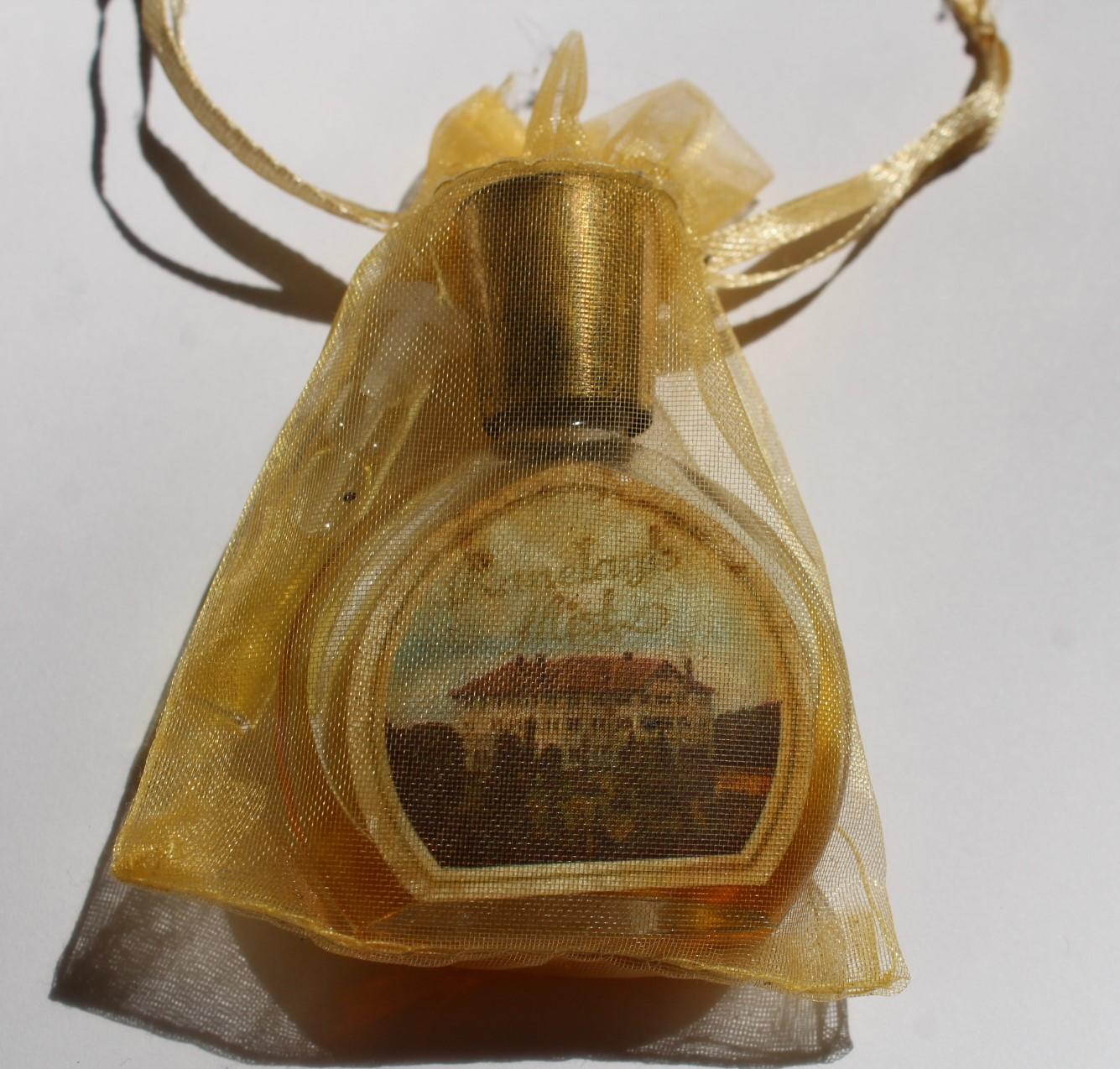
Ranelagh Hotel-Robertson
Formerly known as Ranelagh Hotel and Fountaindale Grand Manor, and currently called The Robertson Hotel. Commenced in 1923 and opened in November 1924, the original structure was built in 122 acres of grounds and had 100 rooms. Ranelagh was originally a public garden in Chelsea opened in 1742, a centre for members of fashionable society to meet and promenade. The gardens were closed in 1804. The word's origin shows they were named after the Earl of Ranelagh, in whose grounds they were sited.
The location of the building itself was chosen for its height, sitting in a majestic position on the escarpment with incredible views out to the entire area. The hotel won the 'Most luxurious hotel in the Commonwealth' award in 1925, and was the first hotel in Australia to have phone lines to every room and its own on-site electricity. Although the Hotel was a success it had cost far too much to construct and three months after officially opening on Friday November 21st, 1924, the investors were going into liquidation:
NEW £55,000 HOTEL AT ROBERTSON
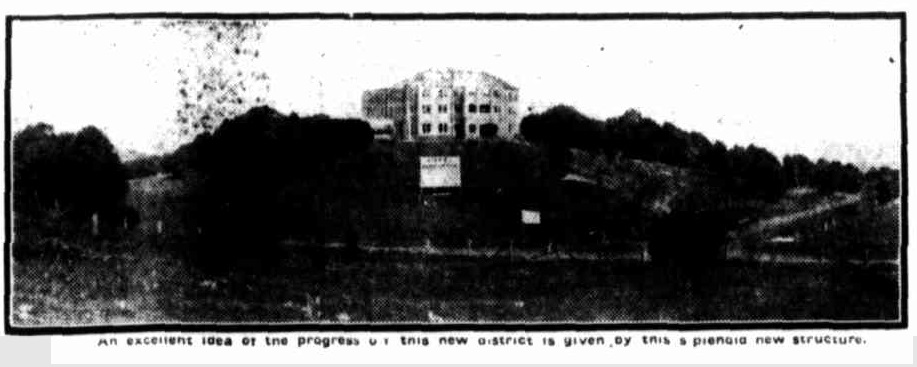
NEW £55,000 HOTEL AT ROBERTSON (1924, April 7). Evening News (Sydney, NSW : 1869 - 1931), p. 1. Retrieved from http://nla.gov.au/nla.news-article119209348
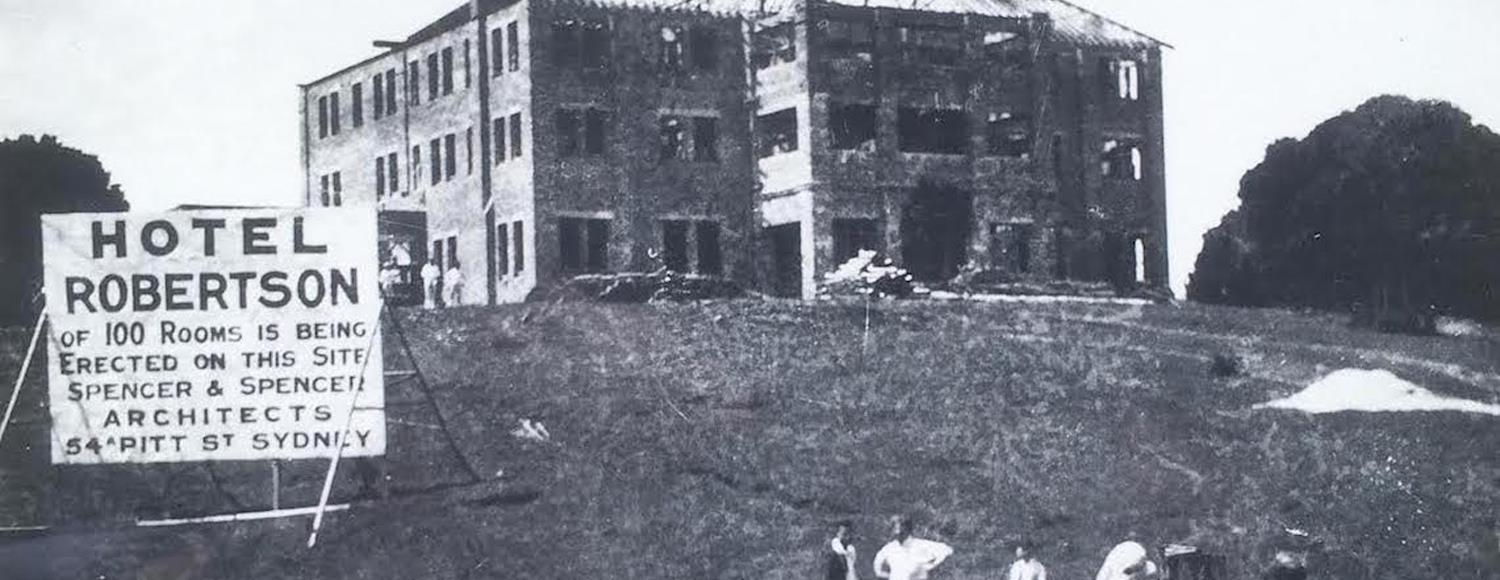
HOTEL ROBERTSON
It is announced that the position of manager of the Hotel Robertson, at Robertson, has been filled. Mr. F. W. Marsh, of New Zealand, having been appointed from over 600 applications. Mr. Marsh has had an extensive experience in hotel management, both in New Zealand and abroad, and was for five years manager and licensee of the Grand Hotel, Rotorua. During his managership there, the Prince of Wales, the admirals of the fleet, Lord Northcliffe, and other notables were guests at the hotel. He will at one take in hand arrangements for the opening of the Hotel Robertson next month. HOTEL ROBERTSON (1924, September 1). The Daily Telegraph (Sydney, NSW : 1883 - 1930), p. 8. Retrieved from http://nla.gov.au/nla.news-article245213957
October becomes November:
ROBERTSON HOTEL
The palatial Robertson Hotel, which has been constructed at a cost of £65,000, including golf links, bowling greens, and tennis courts, is to be opened by the Governor, Sir Dudley de Chair, in the presence of the Premier (Sir George Fuller) and other Ministers of the Crown, within two weeks' lime. The opening will mark a new era in the tourist traffic of Robertson. Over 150 representative citizens are to attend. ROBERTSON HOTEL (1924, November 7). The Daily Telegraph (Sydney, NSW : 1883 - 1930), p. 7. Retrieved from http://nla.gov.au/nla.news-article245462015
And officially opened Friday 21st of November, 1924, with another £10, 000.00 spent:
HOTEL ROBERTSON. OFFICIAL OPENING.
The Hotel Robertson, which has been completed in the township of Robertson, at a cost of £65,000, was officially opened on Friday afternoon by his Excellency the Governor (Sir Dudley de Chair), in the presence of a large and representative gathering. The assemblage included Lady de Chair, the Premier (Sir Geo. Fuller) and Lady Fuller, the Chief Secretary (Mr. Oakes), who was accompanied by Mrs. Oakes and Miss Oakes, the chairman of Hotel Robertson, Ltd. (Mr. Geo. Abbott), Major-General Brand and Mr B. Brand, Sir Arthur Rickard and Lady Rickard, Commander Grant and Mrs. Grant, Mr. Davies, M.L.A., Mr. E. F. Simpson, Mr. E. E. Fosbery, and Mr. J. C. Watson.
The Premier addressed the gathering, following upon the official opening by his Excellency the Governor, and emphasised the advantages of attractive and well-appointed tourist resorts. A tour of Inspection of the building followed the opening ceremony. A dinner at night, in honour of the occasion, was followed by a dance in the ball-room. HOTEL ROBERTSON. (1924, November 25 - Tuesday). The Sydney Morning Herald (NSW : 1842 - 1954), p. 10. Retrieved from http://nla.gov.au/nla.news-article16162442
FIRST FLOOR PLAN OF THE HOTEL ROBERTSON N.S.W.
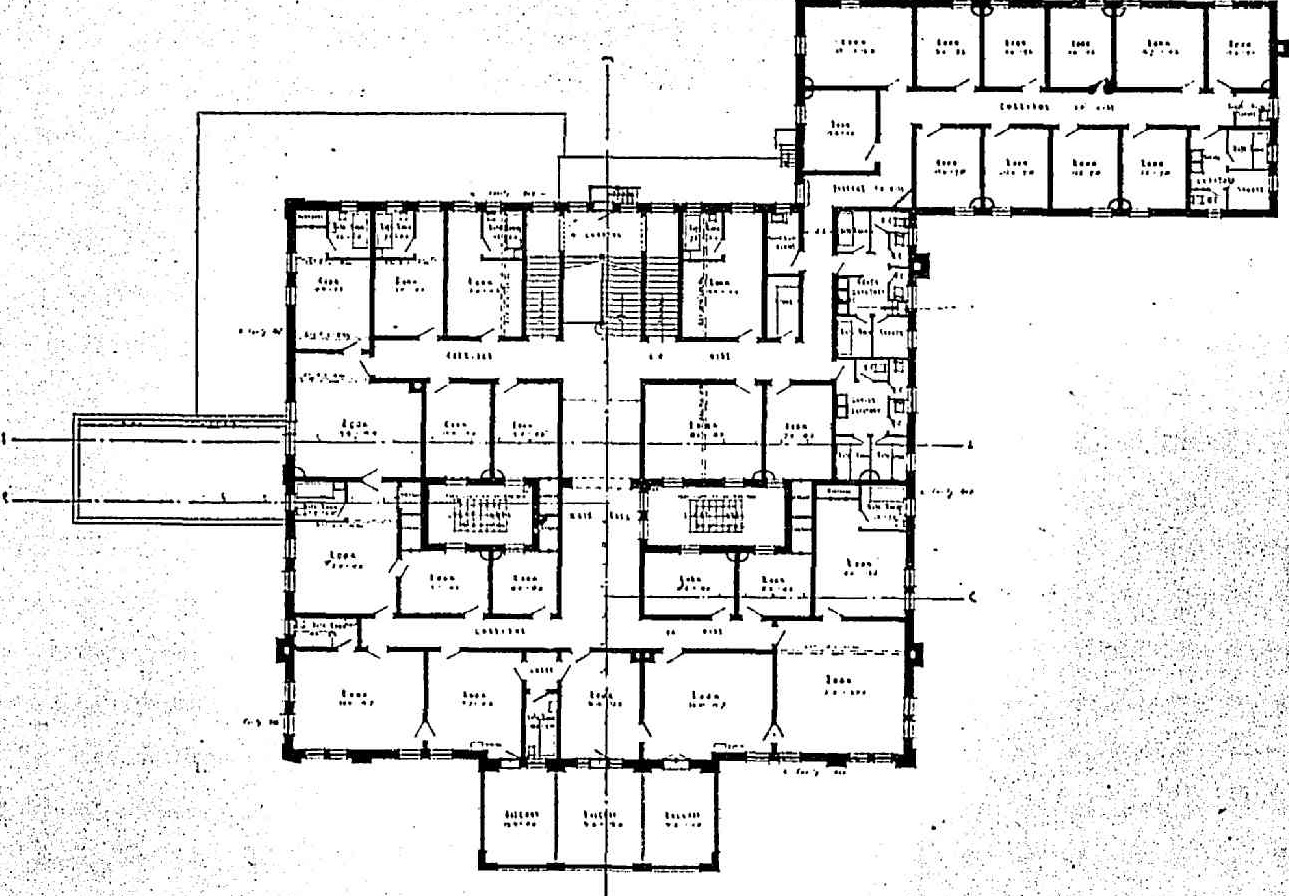
Spencer & Spencer, Architects The most notable feature of this plan is the number of private bathrooms that are attached to the bedrooms or suites or rooms, there being no less than twelve bathrooms to the main portion, and one to the wins over the servants' quarters. Two light wells, which provide a little light and ventilation to the inner rooms, have been introduced in the centres. It would have been preferable to group at least six of the bathrooms round these areas rather than utilise the valuable exterior wall surface for that purpose. Some of the corridors are very poorly lighted, though with the use of electricity, which is-to be generated on the site, this should not be a very serious drawback. No title (1924, November 26). Construction and Local Government Journal (Sydney, NSW : 1913 - 1930), p. 7. Retrieved from http://nla.gov.au/nla.news-article109759671
HOTEL ROBERTSON LIMITED.
Extraordinary Resolution. Passed, 13th February, 1925.
AT an Extraordinary General Meeting of the shareholders of Hotel Robertson Limited, duly convened and held on the 13th day of February, 1925, the subjoined Extraordinary Resolution was passed:—
That it has been proved to the satisfaction of the Company that the Company cannot by reason of its liabilities continue its business, and that it is advisable to wind up the Company voluntarily, and that the Company be wound up accordingly; and That Patrick Francis Dimond, Public Accountant, of 17 Castlereagh-street, Sydney, be, and is hereby appointed Liquidator for the purpose of winding up.
F. W. TURTON, Chairman.
Dated at Sydney, this thirteenth day of February, 1925. HOTEL ROBERTSON LIMITED. (1925, February 27). Government Gazette of the State of New South Wales (Sydney, NSW : 1901 - 2001), p. 1187. Retrieved from http://nla.gov.au/nla.news-article223006449
It is here that a little local connection arises in the form of Arthur Rickard, by then 'Sir' (appointed in 1920), and developer of many a place in Pittwater from Narrabeen to reaches further north. In the 1920s Rickard's business interests included many directorships and part-ownership of the Hotel Sydney, Usher's Metropolitan Hotel and The Windsor, Melbourne. He was a director of Sydney Hospital (1917-27), a council-member of the Sydney Regional Plan Convention (1923-24), a fellow of the Royal Colonial Institute (1912), and of the Royal Geographical Society of London (1924), vice-president of the Defence of Australia League and president of the Japan-Australia Society. He also stepped in to help out the foundering already Hotel Robertson and turn it into the Ranelagh Country Club:
INAUGURATION OF THE RANELAGH COUNTRY CLUB AT ROBERTSON.
THE RANELAGH COUNTRY CLUB WAS OPENED ON SATURDAY BY SIR GEORGE FULLER.
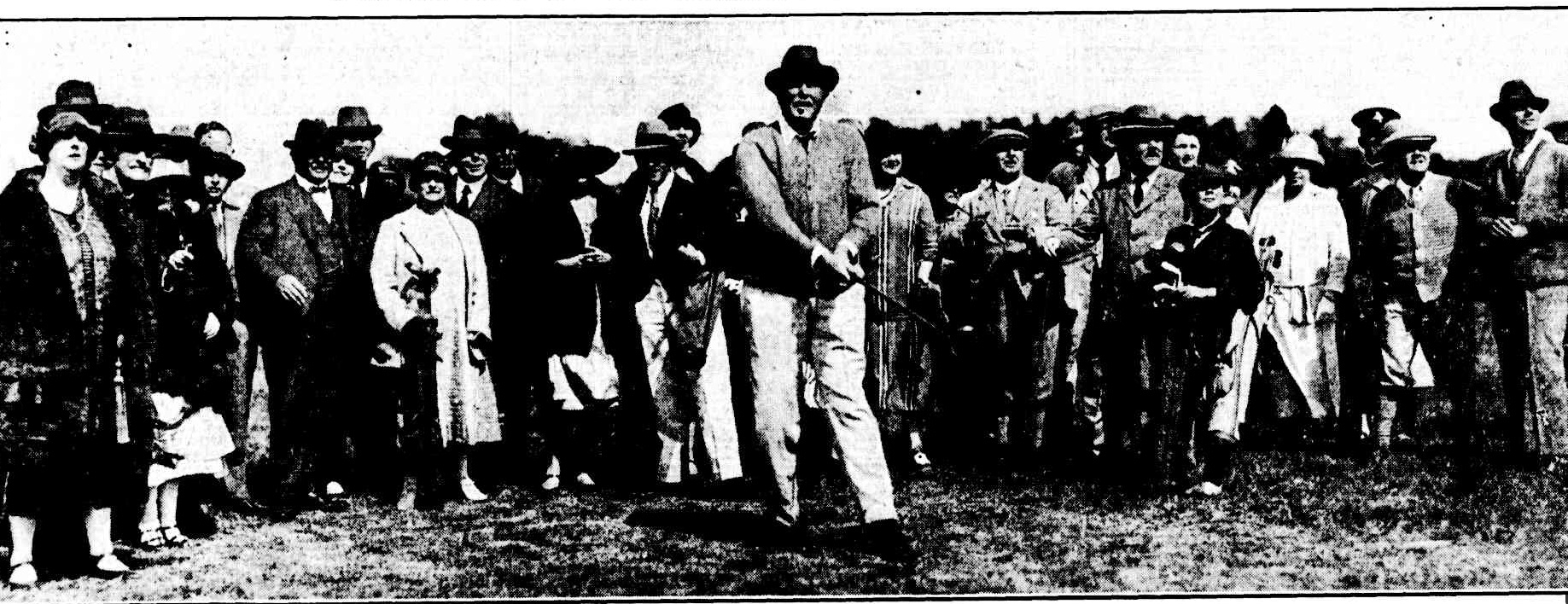
Among those who attended the opening ceremony wore the Chief Secretary (Mr. Lazarini), the Minister for Justice (Mr. McKell), the Assistant Minister for Health and Local Government (Mr. Fitzgerald), Mr. J. F. Coates, M.L,C., Sir John Vicars, Sir Arthur Rickard, and Mr. J. Kell (governor of the Commonwealth Bank). INAUGURATION OF THE RANELAGH COUNTRY CLUB AT ROBERTSON. (1925, December 14). The Sydney Morning Herald (NSW : 1842 - 1954), p. 14. Retrieved from http://nla.gov.au/nla.news-article16266305
Ranelagh Hotel, Robertson.
OPENING OF GOLF LINKS.
The Country Club at Ranelagh Hotel, Robertson, was formally opened on Saturday last particularly fine weather, and with a large attendance of golfers and ladies. In the forenoon a number of golfers played 18 holes for the Buchanan trophy the existing course being nine holes, which will be extended later.
After luncheon at 2 30, Sir George Fuller (ex premier), one of the members for the district, drove the first ball, and opened the course and the club. There was a large company of players, and mixed foursomes were played. At 5 o'clock the whole company assembled in the dance room of the hotel, and Sir Arthur Rickard presided. There were present Sir George Fuller and Lady Fuller, Sir John Vicars, Mr. J S. Coates, M L C (Honorary Minister), Mr Lazzarini (Chief Secretary), Mr. McKell (Minister - for Justice), Mr. T. Murray, M LC, Colonel Murdoch, M L.C , and many others. Sir Arthur Rickard called in succession Mr. Coates, Sir George Fuller, Mr. Lazzarini, Mr. McKell, Colonel Murdoch, and Sir John Vicars to support, the toast of ' Success to the Ranelagh Country Club.'
AMENITY OF CLIMATE
The tone of the speakers was congratulatory of the beauty of the surrounding country, the amenity of the climate, the comfort of the hotel, and the promise of the Country Club. Sir Arthur Rickard, in reply, said he had kept out of the original scheme of the Hotel Robertson, but when the assets were under offer at practically 6/6 in the £, and when it appeared that the furniture would be sent to Sydney and sold, and the place would become a derelict, he stepped in with several of his friends.
They knew that for some years they must lose money, but they hoped that with a property such as this situated among the most beautiful scenery, in the world, and with Mr. Cheeseman, one of the best men in Australia, in charge as managing director, the people would learn to look upon the Hotel Ranelagh as a place where they could depend upon luxurious comfort in practically the surroundings of their own home. It was the hope of the men associated in this Venture that this, the first country club in the State, would soon become appreciated far and wide and would, in association with one of the best hotels in the world, become a favorite holiday place with Australians and their oversea visitors. Ranelagh Hotel, Robertson. (1925, December 16). The Scrutineer and Berrima District Press (NSW : 1892 - 1948), p. 2. Retrieved from http://nla.gov.au/nla.news-article125196424
Another slant on the same story from those old denizens of half-lies; - Truth!:
The Pub That Abbott Built
Sad Awakening to Dreams of Huge Hotel on Heights of Robertson
NOW, George Henry Bruce Abbott, genius of finance, started dreaming. He conceived In the dreams that he had by day and night, a huge hotel, up-to-date In every particular, on the salubrious heights, In the embracing atmosphere of Robertson— one-horse-town Robertson— on the Great Dividing Range down near Moss Vale.
Such dreams as Abbott bad sent Columbus to America, Drake to the Spanish Main, and the forty-niners across the desert to California. But Abbott did not have the luck of any of them. The time, the place, and the opportunity were his, but Dame Fortune looked the other way, showers of bad luck poured down in a devastating stream, and Abbott's bubbles were burst in much the same way as all other bubbles are burst. He put £45,000 of his own fortune Into the venture. He planned, and dreamt the day when Robertson would rise in its glory from the virgin bush and obscurity, the Adirondacks of the Southern tablelands. Holus-bolus he bought up hotels, boarding-houses, shops, cottages, and vacant land. Lawns were set down and golf-links laid out. Yet. as clever as he was with money, Abbott found that even this gigantic dream of his was getting beyond him. So a company was floated with the more or less prosaic title of The Hotel Robertson Company, and fresh capital Was Introduced.
The foundations of the hotel were down. All that was needed was completion, and the road to the realisation of Abbott's dreams. The company paid Abbott £18,500 for the golf links, the land, and the foundations, as well as 10.000 fully paid up shares, and £8500 in cash.
MANSION OF DREAMS
Then brick by brick, floor by'floor, up went the mansion of his dreams, his castle in the air, till the last tile was on the roof, the last marble facing set in Its place in the grand hall, and tho last bottle of old vintage stowed away in its dark, dank space in the cellar. Of his own £45,000, Abbott had spent £21.000 in cash buying the hotels, boarding houses, cottages and land. The land was for subdivision and sale. Over and above that, the hotel building ate into £42,000, but Abbott, with his dreams slowly coming true, reckoned that it was worth it.
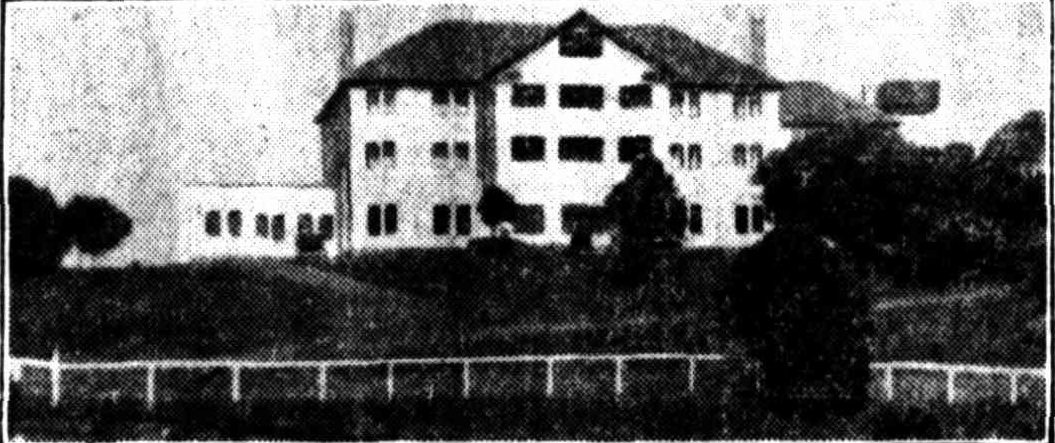
THE HOTEL ROBERTSON. The fruit of Abbott's dream, and now the Ranelagh Country Club.
Perhaps he often stood on the furthermost buttress of his balcony, and glimpsed the panorama of mountain and gully that was to enthrall the elite of the land, looked like taking concrete form. To one great, happy, gigantic guzzle all the wise men, and not so wise men, of the land were invited, and amid salvos of and brine travellers from Alaska and Peru, from Malta and Lord Howe Island. Incidentals— furniture, the fitting out of the honeymoon room with cupids and a box of arrows on the frieze, the blue room, and the green room, as well as the cool room for the breezy bibulous, not to leave out the cellar with its ginger beer, sparkling wines, and old whisky— brought the total cost up to £90,000. truly a huge sum for a country pub — even a hostelry de luxe.
Throughout the length and breadth of the land were the virtues of Robertson advertised, and every small boy who had thought it the name of the man who had invented blow-fly traps, began to look up his geography book, and put a small red cross on the railway line on the map where it stood. People who had never heard of Robertson before began to plan and dream as Abbott had done, to make the wealth that would take them in the plush, seated first-class carriage to this mountain top of enchantment. It was even expected that the Riviera would have its nose put out of joint when the silvertails of Europe came over the Line to Sunny New South Wales to go breathing mountain air at Robertson.
OPENING GUZZLE
Came the day when Abbott's dreams cheers, and the blare of the cornet in the orchestra, the State Governor well and truly declared the Hotel Robertson opened. Maybe, Abbott stood at the door and waited for the clients to arrive. Perhaps some did. But generally the Adirondacks of the Southern Tablelands, began to melt away amid the debris of the dreams that Abbott had dreamt. The place simply didn't catch on, though Robertson— despite its oldest inhabitant, one street, and air that makes the young feel younger, and the old skittish— is one of the most delightful places in the world for a holiday.
Money ran out. It was useless for them to stand on a rock, clap their hands, and pray for a shower of gold. There were no fairy god-mothers hidden away in the gullies, so the company found that it couldn't carry on, and in February last went into liquidation.
But Abbott wasn't going to lose his money, and the money of other people without a fight. Be this to his credit — despite the fact that business simply wouldn't come, and Robertson wouldn't be boosted, he took over the hotel himself, and waited for the birds to sing again; the lager taps to creak, and the champagne corks to pop. Yet, what birds there were kept away, and trilled their warbles for other people.
One by one, his bubbles burst, and two by two his dreams faded away into that region occupied by castles in th£ air. ! It was a pity that such good speeches, and such delectable wines should have, been wasted, but greater schemes than this have crashed to an ignominious end.
ENTER RICKARD AND CO.
In May last, Messrs. Arthur Rickard and Co. obtained an option over the place with the idea of purchasing the whole show for £38,000. Perhaps wiser counsels swayed them in failing to enter where Abbott had so happily trod, for they did not exercise their option, and let the scheme go by. Thus Abbott's last chance of a recovery disappeared, and broke, and, with his dreams gone to the place where all good dreams go, sadly he finally sequestrated his estate, and went into the Bankruptcy Court. Gradually, he went through the various stages of being declared stony, and finally, Official Assignee Lloyd charged him with several offences against the Bankruptcy laws — among them continuing to trade, or obtaining credit after knowing himself to be insolvent; contracting debts without having reasonable expectations of being able to pay the debts and with having given undue preference to a creditor, F. W. Turton, who was given a second bill of sale over furniture. On Monday last, the Registrar, Mr. Lockhart, delivered a lengthy Judgment on Mr. Lloyd's charges, and Abbott's application for a release from Insolvency.
FREED FROM BLAME
Mr. Lockhart freed Abbott from blame. He classed his mistake In keeping on as an error of judgment, and not moral misconduct.
'The bankrupt may have been optimistic in launching the venture,' Mr. Lockhart said, 'but It cannot be said, I think, in view of his financial position at the time, and the nature of the project, that he was acting in a rash or hazardous way. Misfortune overtook the venture, and want of capital prevented the bankrupt from carrying on.
'Under all the circumstances, I think the bankrupt has done nothing to disentitle him to his certificate, but as the giving of the bill of sale was a technical breach cf tho Act, there must be a nominal suspension. 'I, therefore, direct the issue of a certificate subject to a nominal suspension of one day.' Thus was Abbott set free from an lncubus that has kept many another man down. But a man who can make money and lose it as he has done, should be heard of again. Perhaps he will go on dreaming dreams, turning gossamer threads of fancy Into concrete forms, because a man with gumption enough to turn a one-horse town into a second Adirondacks is capable of finding a new way to Heaven.
THIS is the pub that Abbott built. These are the dreams that he used to dream, about the ? pub that Abbott built. j This is the awakening sad and hard, that came to the I dreams he used to dream, about the pub that Abbott built. This is the formal bankruptcy card, that followed the awakening sad and hard, that came to the dreams he used to dream, about the pub that Abbott built. The Pub That Abbott Built (1925, December 20). Truth (Sydney, NSW : 1894 - 1954), p. 12. Retrieved from http://nla.gov.au/nla.news-article168704815
Later the next year - a few Pittwater visitors and holiday home regulars are amongst those named for being present at:
Ranelagh Country Club
The opening of the Ranelagh Country Club, at Robertson, took place on Saturday, and was the occasion for a number of the members of the club meeting at the scene of festivities. Sir John Vicars officially declared the club house open, and the links for play by the breaking of the flag. Thirty golfers contested for the Ranelagh Shield, over 36 hole stroke play. A number of the events were linked up concurrently so that handicap placers could participate in the prize list. At the close of the day a grand plain and fancy dress ball was held in the club's headquarters at the Hotel Ranelagh, a truly carnival spirit permeated the whole of the guests. The costumes were varied, beautiful, and in many cases highly original. The prize for the men's costume was awarded to Mr. O. Bourke, and for the ladies to Mrs. Vallon. The tournament is the first of a series of monthly meetings instituted by the club for their members and golfers from many recognised clubs. The championship event was won by the Concord ex-champion, H. F. Kent. The handicap events were carried off by W. J. Spencer, of Pymble.
Among those present were: Messrs. F. K. Tillock, Morris, Evans, Walker, Magnay, Mr. and Mrs. Weekes and party, Mrs. Warry, Miss J. Rundle, Miss Clarke, Miss Ives, Col. and Mrs. King, jur. and Mrs. warren, Mrs. Say-well and party, Mr. and Mrs. Thomas, Mr. and Mrs. M'Naught, Mr. B. T. Cheeseman, Messrs. H. L. Barns, W. F. Thomas, A- D. Swan, Findlay, Mr. and Mrs. Hemphill, Sir John and Lady Vicars, Sir Benjamin Fuller and Lady Fuller, Mr, Meyer, Misses Barr and Bell. Capt Hill. Mr. and Mrs. A. C. Godhard, Mr. and Mrs. Marcy, Mr. and Mrs. Lee, Mr. and Mrs. Lazzarini, Mr. and Mrs. Fitzgerald, Mr. and Mrs. Fitzpatrick, Mr. Geo. Crowley, Mr. and Mrs. Clifford Hay, Dr. Eric Fisher, Dr. Schlink, Dr. Tibbitt, Mr. E. C. Hattersley, Sir Hugh Dixson, Mr. and Mrs. Campbell, Mr. Cattino, Mr. and Mrs. Spencer, Mr. and Mrs. Marcy, Mr. and Mrs. Paull. Ranelagh Country Club (1926, September 13). The Daily Telegraph (Sydney, NSW : 1883 - 1930), p. 10. Retrieved from http://nla.gov.au/nla.news-article246344365
Not everyone had a successful round of golf:
One of Life's Minor Tragedies
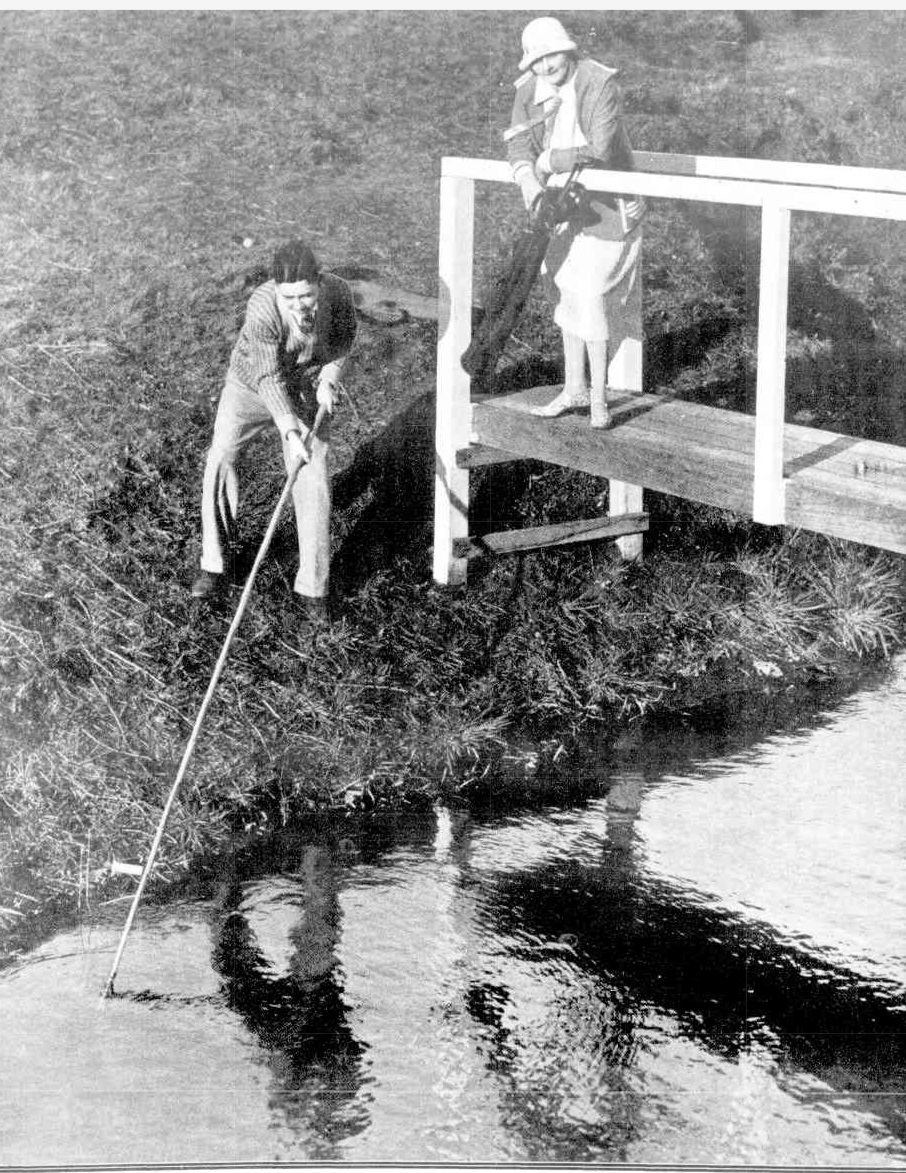
An episode of golf on the picturesque Ranelagh course, at Robertson, N.S.W., which was formally opened on Saturday by Sir John Vicars. One of Life's Minor Tragedies (1926, September 15). Sydney Mail (NSW : 1912 - 1938), p. 7. Retrieved from http://nla.gov.au/nla.news-article166521944
Arthur Rickard & Co. Ltd went into voluntary liquidation in 1930 with Rickard as liquidator. The family's heavily mortgaged mansion—Berith Park at Wahroonga—was sold and they moved to a more modest home at Killara. The onset of the Depression in Australia meant not too many could afford a holiday at the premises.
Re HOTEL ROBERTSON LIMITED (In Liquidation).
NOTICE is hereby given, in pursuance of section 141 of the New 8011th Wales Companies Act, 1890, that a General Meeting of (he Members of the abovenamed Company will be held at the office of Messrs. Halberg, Parsons & Anderson, chartered accountants (Australia), Australia House, Carrington-street, Sydney, on Monday, the seventh day of March, 1932, at 11 o'clock in the forenoon, for the purpose of having an account laid before them showing the manner in which the winding-up has been conducted and the property of the Company disposed of, and of hearing any explanation that may be given by the Liquidators, and also of determining by Extraordinary Resolution the manner in which the books, accounts and documents of tho Company and of the Liquidators thereof shall be disposed of.
Dated the third day of February, 1932.
P. F. DIMOND,
ALFRED J. R. PARSONS,
Liquidators. Australia House, Carrington-street, Sydney.
RE HOTEL ROBERTSON LIMITED (IN LIQUIDATION). (1932, February 5). Government Gazette of the State of New South Wales (Sydney, NSW : 1901 - 2001), p. 584. Retrieved from http://nla.gov.au/nla.news-article220232171
NSW
HOTEL RANELAGH SOLD
The Hotel Ranelagh, Robertson, has been sold. The vendor was Mr. H. B. Pilling, and the buyer Mr. W. T. O'Mara, late of Rose Bay. The hotel has 100 rooms, and stands in about 122 acres of freehold land. It was built about 10 years ago at a cost of approximately £100,000, although the present price has not been disclosed, it is understood to be a great deal below that figure. The sale includes the land, building, licence, goodwill, and furniture. HOTEL RANELAGH SOLD (1934, September 13). Goulburn Evening Penny Post (NSW : 1881 - 1940), p. 8 (DAILY and EVENING). Retrieved from http://nla.gov.au/nla.news-article103655889
However, you can't keep a great place in a beautiful location down:
POLO AT RANELAGH
THE picturesque polo grounds at Ranelagh, situated on the top of the cliff with glimpses of blue sea shining enticingly through the ti-tree formed an ideal setting for the large crowd of spectators who motored from Frankston and Melbourne to watch the matches last Saturday afternoon. It is always an informal gathering, and cars can be driven right up to the ground so that everyone can watch the play comfortably seated. Almost every car load makes a day of it, and many picnic parties camp beneath the trees overlooking the sea.
On Saturday many players and their friends stayed to dine at Stewart's Hotel and afterwards attended a dance at Ranelagh Club House.
Noticed among the large crowd of spectators at the polo were:—Sir Robert and Lady Knox, Colonel and Mrs W. Knox, Mr and Mrs Campbell Chomley, Miss Roma Chomley, Miss Muriel Graham Officer, Miss Amy Smith, Mr and Mrs Angus Urquhart, Mrs Ffrench, Mr Hodgson, Mr Frank Donaghy, Mr Cecil Le Plastrier, Mrs Percy Aldertou, Misses Gertrude and Helen Rennie, Dr. and Mrs A. Law, Mrs Charles Bright, Mr and Mrs J. R. Dunstan, Miss McGregor, Mr and Mrs Louis Nelken, Mrs Lort Smith, Miss M. Montgomery, Major-General G. Johnstone, Mr and Mrs Norman Trenery. Mrs J. Stanley Smith, Mr and Mrs S. O. Woods and their sons Phil, David and Wilfred, Mr and Mrs J. V Edgar, Mr and Mrs Herd, Mrs Edmund Collins, Miss Helen Good (Croydon), Mr and Mrs T. B. Guest, Mr and Mrs Trevor Oldham, Colonel Dare, Mrs Taylor, Mrs Faulkner and her daughter Pamela, Miss Ursula Syme, Mr Hodgson, Mr Le Plastrier, Colonel and Mrs Humphrey Clegg, Dr. and Mrs Sidney Plowman, Mr and Mrs N. Gray, Miss Alison Madden, Miss Jean Turnbull, Mr and Mrs D. Detmold. Mr and Mrs Gooch, Mr and Mrs Hope Campbell, Mrs dive Fairbairn, Miss Truda Fairbairn, Miss Chili Reid, Miss Pat Robertson (Camperdown), Miss B. M. Little, Mr and Mrs Herd, Miss Isabella Anderson. POLO AT RANELAGH (1936, February 6). Table Talk (Melbourne, Vic. : 1885 - 1939), p. 36. Retrieved from http://nla.gov.au/nla.news-article152063385
There have been a few name changes along the way - it commenced as the Hotel Robertson, then was known as the Hotel Ranelagh, Ranelagh Country Club, Ranelagh House and Fountaindale Grand Manor have added to the mystic that is now called The Robertson Hotel.
A rich history has seen the Manor style premises change faces throughout its 96 years – it was a WRAAF base during the war, a hospice for returning pilots, St Anthony’s college and a Franciscan friary and seminary. It was during this period that the beautiful stained glass windows, rock walls and fountains were built. These are still in the building and around the gardens and grounds.
In 1969 The Robertson Hotel became home to the Greek Orthodox Church before becoming what it is today, a hotel and function centre.
The current 'Robertson Hotel' is still a beautiful place and those looking after this building and its grounds also have a little history to share about the construction:
There is not one part of the building and its grounds that hasn’t been touched by skilled local hands, with everything from the plumbing to the plastering painstakingly constructed by long-trusted local businesses.
Even the ornate ceilings were the handiwork of GR. LUMB & SONS, which employed 10 people using the traditional lath and plaster method of genuine horsehair and mortar. It took a painstaking and methodical six months to complete and it not only gives incredible strength to the building, but it lends it a beautifully antiquated character.
The actual builder of the Manor, local icon Alf Stephens from Alf Stephens & Sons, employed the expert craftsman to create this incredible manor. A little known fact was that Stephens was best mates with Sir. Donald Bradman, through his position as Captain of the Bowral Cricket Club. It was Stephens who originally cut down a bat to suit Bradman’s shorter stature, which then propelled the batsman to the legendary status he enjoyed throughout his career, and to this day and beyond.
In an interview with the Sunday Sun in January 1930, George Bradman, Don's father, stated: "Mr. Alf Stephens, a prominent member of the Bowral Club, brought Don's name before the big men of cricket … I am very, very thankful for the interest taken in my lad."
Indeed, if our walls could talk, we’re sure they could spill plenty of raucous tales of Bradman and Stephens enjoying a laugh and a friendly game around the manor and its grounds.
The link with great sporting icons doesn’t stop there. In one of the staff change rooms, there is etched on the wall the odds on several horse races of the day, with the name Phar Lap coming up more than once!
The Hotel has always had a deep connection with healing. Following World War II the healing properties of the building and its grounds were evident, with many veterans enjoying lengthy stays in order to rest and recover. This healing ambience is still evident today, with clean, crisp air, lush garden surrounds, rolling mists and a pristine silence that will ensure you will sleep more soundly than you have ever before.
Likewise, the Hotel has always had a strong connection to animals and their welfare. In 1947, the building briefly became a Franciscan Friary and seminary, which is when the beautiful stained glass windows, rock walls and fountains were installed. Known as protectors of animals, the Franciscan monks kept peacocks and all manner of animals on the grounds.
Then, in the 1980s, it was a haven to injured wildlife, with its owners at the time taking in all manner of injured native marsupials. You will still notice signage around the grounds, warning drivers to heed their speed to protect the natives. What’s more, the much-loved 1995 film, Babe, was actually filmed on the Grounds of the Robertson Hotel, and you can glimpse the Hotel in the background in quite a few scenes. It is with this in mind that we intend on opening a petting zoo, for children of all ages to enjoy the beauty of many native and exotic species.
We will be offering historical tours of the hotel, so you can experience this personally during your stay and see for yourself why it was named the “Most Luxurious Hotel in the Commonwealth”, back in 1925.
Well worth a visit as this grand old building heads towards its centenary celebrations - and you don;t have to stay there, there's a great dining room too. Just make sure you see it during during Autumn, Winter or Spring, so you can get a good whiff of what real Robertson mist smells and tastes like - perfect!
Find out more at: http://therobertsonhotel.com/
